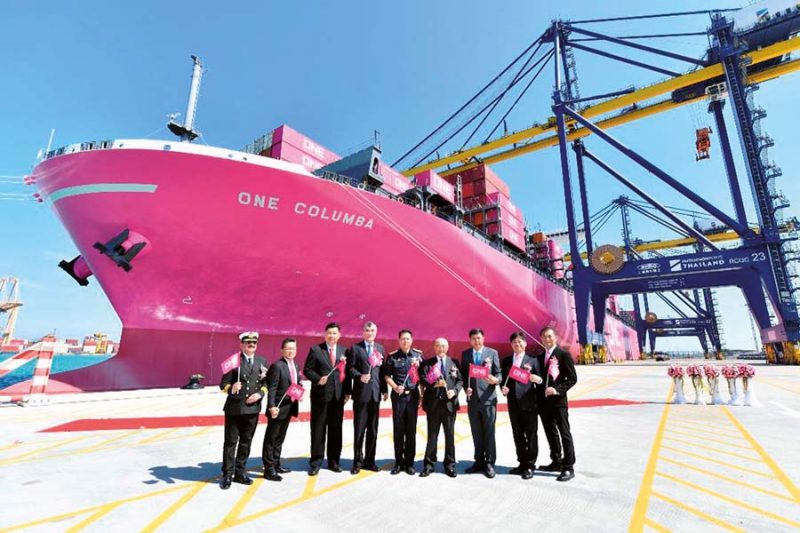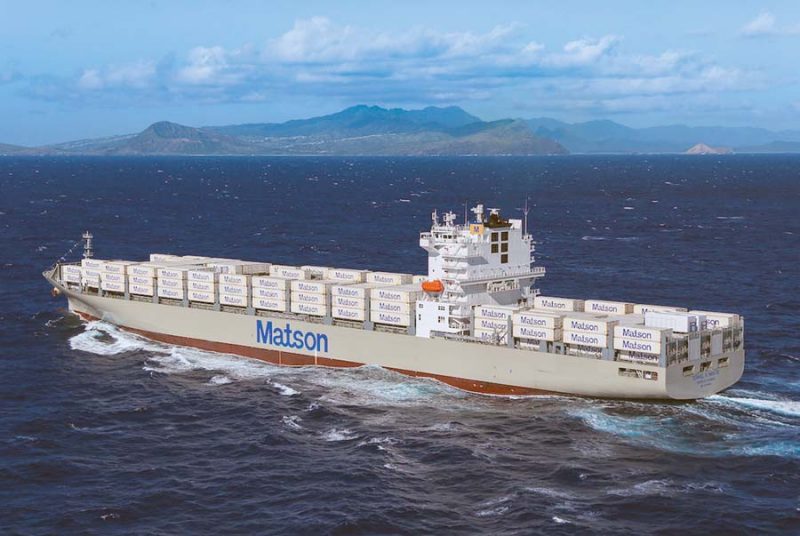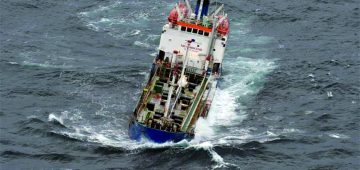APL announced on 22nd November refinements to the West Asia Express (WAX) and West Asia Express 3 (WA3) services in its Asia-Gulf network. The improved WA3 service extends the network to Jubail and Bahrain from Lianyungang and Hong Kong with calls at Hamad & Sohar from Ningbo and Bahrain from Tianjin. So, the new WAX service commenced from Tianjin on 6th December with the following rotation: Tianjin-Qingdao-Ningbo-Shekou-Singapore-Sohar-Jebel Ali-Hamad-Bahrain-Damman-Port Klang-Singapore-Yantian-Xiamen-Ningbo-Shanghai and Busan. The improved WA3 service commenced from Busan on 4th December calling at Busan-Lianyungang-Qingdao-Shanghai-Hong Kong-Shekou-Singapore-Jebel Ali-Damman-Jubail-Abu Dhabi-Singapore-Nansha and Busan.
CMA CGM announced on 13th November that it was revamping the dedicated CIMEX 2K2 service connecting Asia with India and Pakistan to include calls at Karachi SAPT and Nhava Sheva BMCT, weekly sailings covering China, Singapore, Malaysia, India, Pakistan plus a new direct connection from Nansha to Karachi. The rotation is Shanghai-Ningbo-Shekou-Nansha-Singapore-Port Klang-Nhava Sheva (BMCT)-Karachi (SAPT)-Singapore-Shanghai. The revised service departed from Shanghai on 14th November in the hands of the 113,828gt/2018 built Kota Pemimpin.
Costamare of Greece has taken full ownership of five 2014 built 14,000 TEU capacity containerships. The move saw Costamare acquire the remaining 60% equity interest in the vessels from York Capital, which contracted the ships in 2014 via a joint venture with the Greek owner. Under the deal, Coastamare has an option to defer 75% of the purchase price for up to 18 months after closing, as well as the option to pay part of the purchase price with shares of the company’s common stock. The boxships are employed on long term charters to Evergreen, expiring in 2026. Costamare has a fleet of 79 containerships, with a total capacity of approximately 549,000 TEU, including five containerships under construction.
Crowley Maritime Corporation announced at the end of November that it planned to complete the merger of its liner services group into Crowley Logistics. The restructuring will be completed as of 1st January 2019. Integrating liner services into logistics was planned as part of a corporate restructuring announced earlier in 2018, consolidating Crowley into four business units – Crowley Fuels, Crowley Solutions, Crowley Shipping and Crowley Logistics. The company’s two new Con-Ro ships were featured as Newbuild of the Month in the January issue.
Hapag-Lloyd revealed details of its Strategy 2023 on 21st November. The company has more than doubled in size since 2014 in terms of transport capacity and the new strategy is based on various elements: Key cost initiatives focus on network optimisation, terminal partnering and further improvements in procurement and container steering. Furthermore, an optimised revenue management will ensure that the most attractive cargo gets on board. At the core of the new Strategy is an enhanced differentiation by offering unrivalled levels of reliability and service quality. Hapag-Lloyd is making changes to its structures, systems, processes and operations and focussing on delivering customers a better and more efficient experience in their supply chains. At the same time, additional improvements aim to turn Hapag-Lloyd into a more agile, dynamic and analytically driven organisation. More investments in digitalisation and automation will be made to further exploit digital excellence. One example is to increase the share of the online business via the web channel to 15 percent of Hapag-Lloyd’s overall volume by 2023. In other news, ten 13,000 TEU capacity Hamburg Class ships are to be retrofitted in 2019/2020 with Hybrid Ready Exhaust Gas Cleaning Systems (EGCS), starting March 2019. The modifications are being made due to the so-called IMO2020 regulation that limits the sulphur emissions caused by marine fuels to 0.5% as of 1st January 2020. Hapag-Lloyd also has 17 new vessels in its fleet, which can be converted to use LNG. The company will retrofit one such 15,000 TEU capacity vessel during 2019 to evaluate the suitability of LNG as a suitable alternative to low sulphur fuel.

Maersk Line’s 194,849gt/2013 built Maersk Mc-Kinney Möller (above) visited the River Thames in the last week of November to call at DP World’s London Gateway. This was the first call of the AE/7Condor service operated by the 2M+1 Alliance. The 399m long and 18,720 TEU capacity vessel is exactly the type of ship that the UK’s newest port was designed for. The AsiaEurope service will now be calling at London Gateway on a weekly basis carrying cargo between the Chinese mainland, Hong Kong, North Africa and Northern Europe, along with sister ships of 17,500-19,500 TEU capacity. Coincidentally the news of the AE/7Condor service calling on the River Thames came as London Gateway celebrated its 5th birthday on 6th November. A.P. Møller-Mærsk A/S announced on 14th November that growth had been achieved in the third quarter of 2018 in both Ocean and non-Ocean sectors, with a total revenue increase of 31% to $10.1 billion, or 12% excluding Hamburg Süd operations. Furthermore, gateway terminals continued to grow volumes from external customers as well as from Maersk Line and Hamburg Süd reflecting synergy impact from the closer collaboration. Total synergies with Hamburg Süd of a minimum of $500 million excluding integration cost are expected by 2019 as the integration is progressing faster than planned.The underlying profit in this quarter amounted to $251 million compared to $254 million in the same period of 2017. Earnings before interests, tax, depreciation and amortization (EBITDA) increased by 16% despite bunker prices increasing by 47%. On 4th December the company revealed plans to have carbon neutral vessels commercially viable by 2030 and called for strong industry involvement. Aimed at accelerating the transition to carbon neutral shipping, Maersk announced its goal to reach carbon neutrality by 2050. To achieve this goal, carbon neutral vessels must be commercially viable by 2030, and an acceleration in new innovations and adaption of new technology is required. Given the 20-25-year life time of a vessel, it is now time to join forces and start developing the new type of ships that will be plying the oceans in 2050. In 2019, Maersk is planning to initiate open and collaborative dialogue with all possible parties to tackle one of the most important issues in the world, the climate change.

OOCL introduced new South Africa Service 1 (SAF1), South Africa Service 2 (SAF2) and South Africa Service 3 (SAF3) services effective from 6th December, 30th November and 11th December respectively. The SAF1 calls at Shanghai-Ningbo-Keelung-Singapore-Durban-Singapore-Shanghai, SAF2 serves Kaohsiung-Xiamen-Hong Kong-Shekou-Singapore-Port Klang-Durban-Cape Town-Port Klang-Singapore-Kaohsiung and SAF3 calls at Xingang-Qingdao-Shanghai-Ningbo-Nansha- Singapore-Port Klang-Durban-Port Elizabeth-Port Klang-Qinzhou-Hong Kong and Xingang. The company then presented a new West Africa Service 2 (WAF2) service from 30th November calling at Dalian-Xingang-Qingdao-Inchon-Ningbo-Nansha-Singapore-Cape Town-Apapa-Tincan-Onne-Singapore and Dalian. A few days later, on 6th and 4th December respectively, OOCL introduced enhancements to both the Asia-Middle East Service 1 (ME1) and Asia-Middle East Service 3 (ME3). The revised ME1 port rotation is Tianjin-Qingdao-Ningbo-Shekou-Singapore-Sohar-Jebel Ali-Hamad-Barhain-Dammam-Port Klang-Singapore and the new ME3 port rotation is Pusan-Lianyungang-Qingdao-Shanghai-Hong Kong-Shekou-Singapore-Jebel Ali-Dammam-Jubail-Abu Dhabi-Singapore-Nansha and Pusan. OOCL then extended the East Mediterranean service network to the Middle East and Indian Subcontinent on 6th December by introducing the new Middle East/Indian Subcontinent-East Mediterranean Service (EM3), to be launched in January 2019. The EM3 port rotation will be Hamad-Jubail-Jebel Ali-Mundra-Nhava Sheva-Colombo-Port Said West-Mersin-Piraeus-Istanbul- Mersin-Iskenderun-Jebel Ali-Abu Dhabi-Hamad. The revised EM3 service began westwards with the 95,390gt/2013 built MSC Athos at Hamad on 7th January and eastwards with the 94,469gt/2015 built MSC Maxine at Piraeus on 2nd January.

ONE announced on 16th November that it had taken delivery of the 14,000 TEU capacity One Columba (above) from the Kure Shipyard of Japan Marine United Corporation. The shipbuilder was Nippon Yusen Kaisha. The ship is ONE’s fourth newbuild following the ONE Stork (12th June), ONE Minato (26th July) and the ONE Aquila (7th September). There are currently 3 more vessels in the series for delivery in 2019. The ship was phased into THE Alliance’s Asia to Europe, Far East Europe 5 (FE5) service, with its port rotation of Leam Chabang-Cai Mep-Singapore-Colombo-Suez Canal-Rotterdam-Hamburg-Antwerp-Southampton-Suez Canal-Jeddah-Colombo-Singapore and Laem Chabang. Ocean Network Express expanded its Asia-South America service from 2nd December. The additional weekly offering enhances ONE’s service frequency and broadens its coverage between Asia and the east coast of South America. The Asia-South America East Coast Express 1 (SX1) calls at Pusan-Shanghai-Ningbo-Shekou-Yantian-Hong Kong-Singapore-Santos-Paranagua-Navegantes-Montevideo-Buenos Aires-Rio Grande-Navegantes-Paranagua-Santos-Coega-(Port Klang)-Singapore-Hong Kong-Pusan. The SX2 rotation is Pusan-Shanghai-Ningbo-Hong Kong-Shekou-Singapore-Sepetiba-Santos-Itapoa-Itajai-Buenos Aires-Montevideo-Itajai-Paranagua-Santos-Singapore-Hong Kong and Pusan. On 27th November the 145,647gt/2018 built and 364m long/51m beam ONE Columba, with a capacity of 14,053 TEU, became the largest containership to call at the incomplete 1,700m long Terminal D at Hutchinson Ports Thailand’s Laem Chabang Port. At the beginning of December, a ONE operated ship, the 55,534gt/2007 built NYK Nebula, successfully rescued a distressed Canadian sailor on board a yacht in the North Atlantic Ocean after the vessel had suffered a torn sail. Having picked up the yachtsman, the NYK Nebula continued on her voyage to Southampton.

Matson Inc. welcomed the first of four Aloha Class newbuilds on 29th November when the largest containership built in the U.S.A was introduced onto its Hawaii service. Named in honour of Hawaii’s late senior U.S. Senator, the 48,409gt/2018 built Daniel K. Inouye (above) is the largest ship of her type ever built in the U.S.A with a capacity of 3,600 TEU and a speed of 23 knots. The LNG fuelled ship’s arrival also marks the beginning of a $1 billion investment by Matson in the Hawaii service including the remodelling of the Sand Island facility in Honolulu. The container carrier has also filed a federal suit in an effort to reverse Maritime Security Program (MSP) enrolment for two vessels operated by competitor APL, a subsidiary of CMA CGM. Some years ago, APL’s request to replace two existing subsidised ships with the feeder ships APL Guam (13,764gt/ built 2001) and APL Saipan (16,916gt/built 2002), which were repositioned to serve Guam and Saipan. According to Matson, these two subsidised vessels “directly compete with Matson’s unsubsidised vessels that operate in these domestic trade routes,” creating unfair competition. It is said that, as a result of the subsidies, APL is able to offer significantly lower prices than Matson for shipping cargo on the same routes, driving carriage from Matson to APL and altering the competitive balance in this domestic market. The subsidy is not the only operating difference between the two services. Matson uses American-made vessels on its mainland-Guam routes, but APL does not. Like almost all ships subsidised under the Maritime Security Program, the APL Guam (formerly the New Dynamic) and APL Saipan (formerly the Elisa Delmas) are foreign built. Purchasing a foreign-made vessel typically conveys substantial savings, and Guam is exempt from the Jones Act’s U.S. build requirement.
Wan Hai Lines of Taiwan has signed a contract for the order of 20 container vessels consisting of eight 3,036 TEU container vessels from Japan Marine United Corp. (JMU) and twelve 2,038 TEU container vessels from Guangzhou Wenchong Shipyard Co. Ltd./China Shipbuilding Trading Co. Ltd. (GWS/CSTC). Delivery of the 3,036 TEU vessels will begin at the end of October 2020 and delivery of the 2,038 TEU vessels will begin in early January 2021. Wan Hai Lines has the option to order an additional four 3,036 TEU vessels within six months and four 2,038 TEU vessels within three months. The company presently operates a fleet of 72 owned vessels and 24 chartered vessels.
X-Press Feeders of Singapore has approached China’s Zhoushan Changhong International Shipyard to build six new 2,700-TEU capacity feeder vessels. Each of the environmentally-friendly feeders, to be classed by DNV GL, will be capable of carrying 600 refrigerated containers. China State Shipbuilding Corporation’s (CSSC) 708th research institute Maric will design the vessels with a focus on energy efficiency and environmental friendliness. The hull of the vessels will be optimised to reduce bunker fuel consumption and the vessels will also satisfy the EEDI phase 3 requirements needed from 2025.





Comments
Sorry, comments are closed for this item